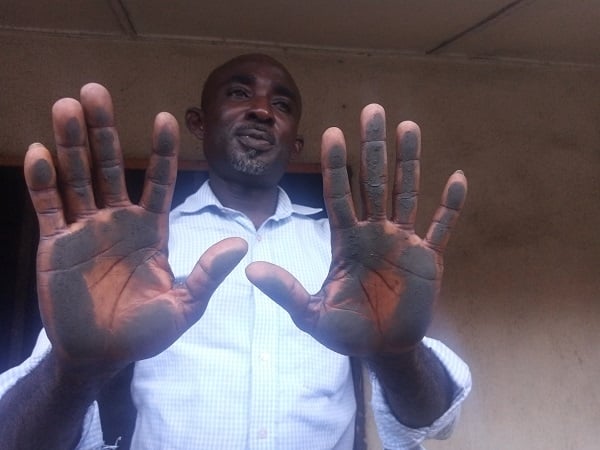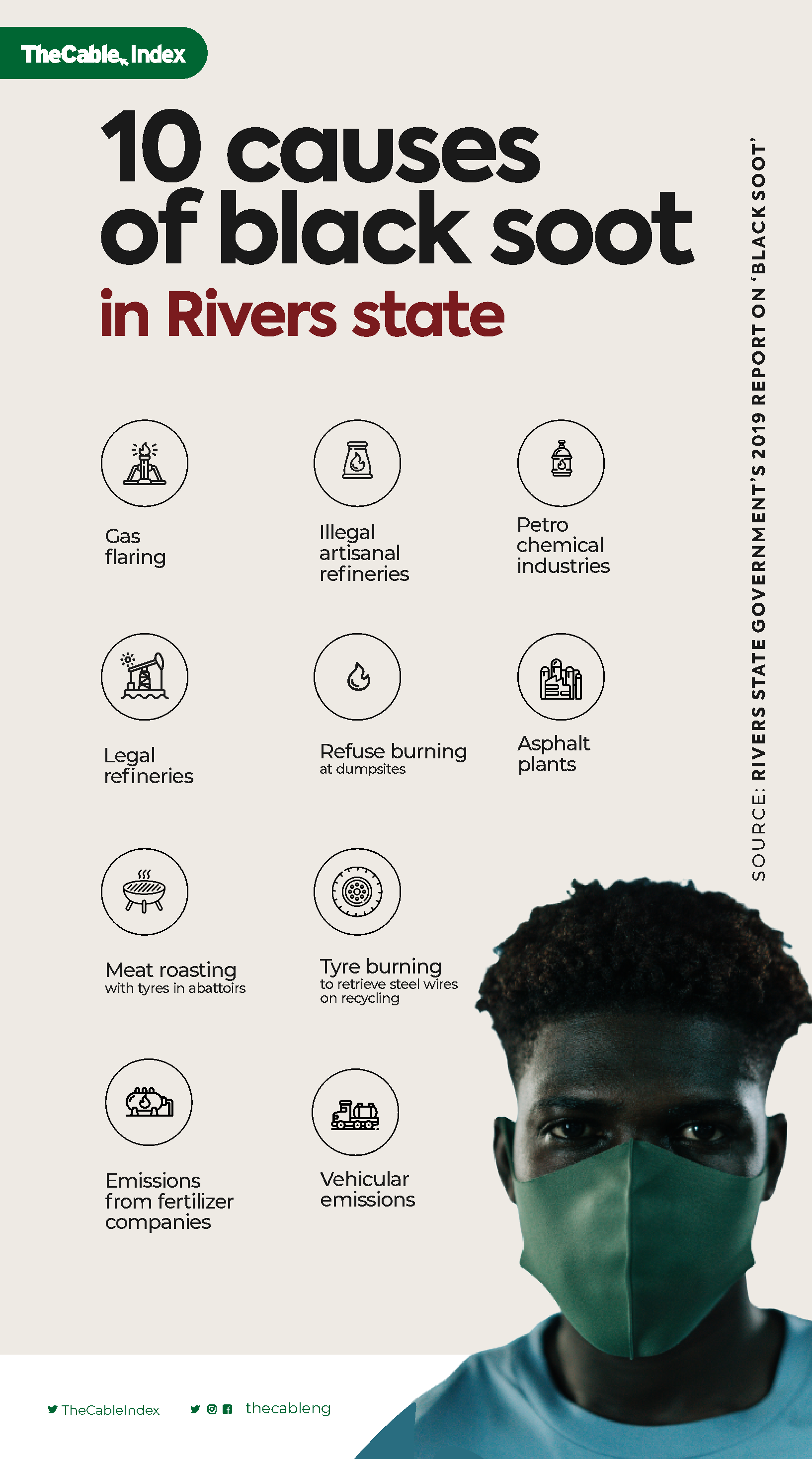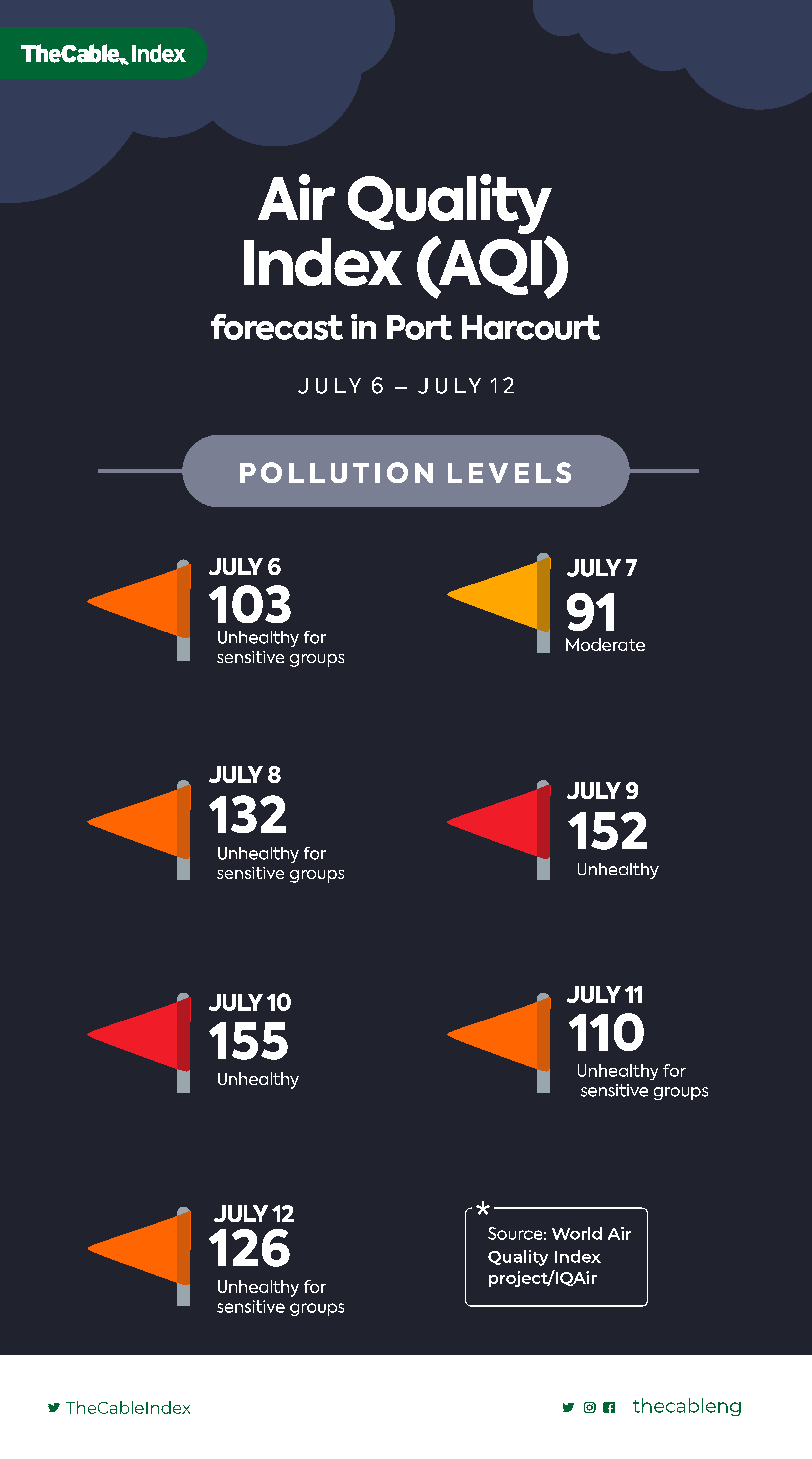Chidiebere displaying soot deposited on his window nets
Nmesoma Esther and her siblings were lost in their world as they roamed their three-bedroom flat. With little to worry about, they giggled at intervals and bounced around with reckless abandon. Esther was happy to enjoy the evening hours before having to face a familiar demon at night.
The nine-year-old girl suffers respiratory distress syndrome (RDS) — a breathing disorder among children which causes insufficient surfactant in the lungs.
Every night, Esther endures pain and discomfort due to her inability to breathe well. But her hope of overcoming the condition is continually dampened by the relentless activities of the artisanal refiners who operate behind her house every day.
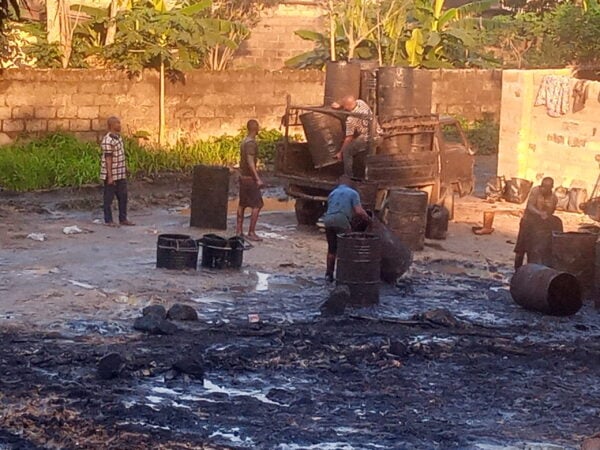
In 2017, her family relocated to Ohanachiom street, Obigbo west in Oyigbo LGA of Rivers. Since their arrival at the new environment renowned for heavy pollution, her condition has worsened.
Advertisement
“My chest used to be heavy whenever I try to breathe. I don’t also sleep well at night because I don’t breathe well,” she said, wearing a defeated look.
Daily, Esther watches as soot filters through the windows and falls on the ceiling fans, curtains, TV, chairs, and furniture. Nothing in the house is spared.
Esther’s situation depicts a state of helplessness. But she’s not alone.
Advertisement
Aririguzo Chidiebere(pictured), another resident of Ovim-street in Oyigbo LGA, could not hide his frustration.
“The soot issue has been a hell of an experience for us. We’re prone to catarrh always and we sneeze a lot. Most times, when you blow your nose, you’ll notice everything is black,” he said.
SOOT, THE SLOW KILLER
Advertisement
Soot is the common term for a type of particle pollution called PM 2.5 — particulate matter with diameters that are 2.5 micrometers or less.
It is mostly formed as a result of the incomplete combustion of hydrocarbons, and due to its tiny size, it can penetrate the lungs and bloodstream easily.
According to the US Environmental Protection Agency (EPA), soot is one of the deadliest forms of air pollution.
Precious Ede, a climate scientist and air pollution specialist at Rivers State University (RSU), said soot contains harmful chemical substances that can cause cancer and respiratory disorders.
Advertisement
The harmful substances, the professor said, are heavy metals, total petroleum hydrocarbon (TPH), polyclinic aromatic hydrocarbons (PAHs), diesel fuels, mineral oils, benzene, toluene and xylenes.
In spite of its deadly nature, residents of Rivers have continued to grapple with it.
Advertisement
Following the outrage that trailed its prevalence in 2016, Nyesom Wike, the state governor, had commissioned a technical team in 2018 to investigate the factors causing soot pollution and how to tackle it.
According to the report published in 2019, a copy of which was obtained by TheCable, illegal bunkering and gas flaring topped the list of activities causing soot pollution in the state.
Advertisement
The report — citing a review of hospital records across the 23 LGAs in Rivers — also revealed that 22,077 persons who received treatment for soot-related conditions between 2014 and 2018 suffered respiratory ailments.
Advertisement
Ede, who led the technical team, told the TheCable that findings showed there was “30% increase in morbidity and mortality rates in Rivers state 16 months after the soot incident started in 2016”.
“We concluded that the soot is a source of the very harmful condition that is already killing people. We also looked at the results of laboratory analysis and projected possible rate of cancer occurrence among residents of Port Harcourt,” he said.
“And we were able to come up with information showing that thousands of people will come down with cancer annually as a result of soot.”
Harmful chemical composition of ‘black soot’ and effects on human health
| Pollutants | Health effects on residents | ||
|---|---|---|---|
| 1. | Arsenic | Headaches, drowsiness, seizures, brain damage, diarrhea, low blood pressure, muscular problems, heart problem and intestinal bleeding. | |
| 2. | Lead | Brain damage, mental retardation, anemia, depression, insomnia and respiratory distress | |
| 3. | Mercury | Respiratory problems (asthma, bronchitis, pneumonia, etc.) and neurological problems such as loss of memory, mental confusion and lack of concentration. | |
| 4. | Total petroleum hydrocarbons (TPH), e.g., benzene, xylenes, mineral oils, diesel fuels … | Decreased immune system, breathing problems, severe kidney and liver damage and mental problems. | |
| 5. | Polycyclic aromatic hydrocarbons (PAHs), e.g., naphthalene, fluorene, anthracene, phenanthrene, etc. | Breakdown of red blood cells (hemolysis), jaundice, cancer, catarrh, kidney and liver damage, breathing problems and body stress. | |
Source: Laboratory analysis of chemical characterisation of soot (Rivers state government’s 2019 report) and interviews with experts.
AirVisual’s ranking of air quality in Port Harcourt between June and July 2021 showed that it is mostly unhealthy for the residents. On July 9, for instance, an air index of 152 was recorded for the city — far above the standard(0-50) and moderate(51-100) levels.
According to Ede, people like the nine-year-old Esther with pre-existing conditions are more likely to suffer serious health challenges due to the poor air quality in Port Harcourt and other parts of the state.
‘DEPRESSED LUNG FUNCTION ACTIVITIES’
To ascertain the effect of soot on residents, TheCable facilitated lung function tests and chest x-ray for 10 people living in areas where the scourge is prevalent.
Based on the direction of medical experts, and to obtain reliable results, residents selected for the tests were neither smokers nor did they have any known pre-existing health issue.
The lung function test was carried out at the department of human physiology laboratory, college of health sciences, University of Port Harcourt (UNIPORT) while the chest x-ray was conducted at Splendour Diagnostic Centre — both in Obio/Akpor LGA.
The participants selected for both tests were within the age range of 22 and 33, and drawn from Port Harcourt, Oyigbo, Obio/Akpor and Ikwere LGAs.
For the lung function test, the parameters used include forced vital capacity (FVC) — the amount of air that can be forcibly given out from the lungs after taking the deepest breath possible; and forced expiratory volume (FEV1) — the amount of air that can be expelled forcefully in one second.
Others are peak expiratory volume (PEF), which is the highest amount of expelled air; and FEV1/FVC, the ratio of the amount of air that can be expelled forcefully in one second to the total amount of air expelled.
The chest x-ray examined the heart size and contour, the lung fields, and the aorta, which is the main artery of the body supplying oxygenated blood to the circulatory system.
The bony rib cage and pleural effusion — abnormal, excessive collection of fluid next to the lung — were also examined.
Results of the lung function test showed that none of the participants used — two females and three males — had standard lung function activities.
Only two of the respondents (40%) had “fairly okay” lung function activities while the remaining three (60%) had “between depressed to seriously depressed lung function activities”.
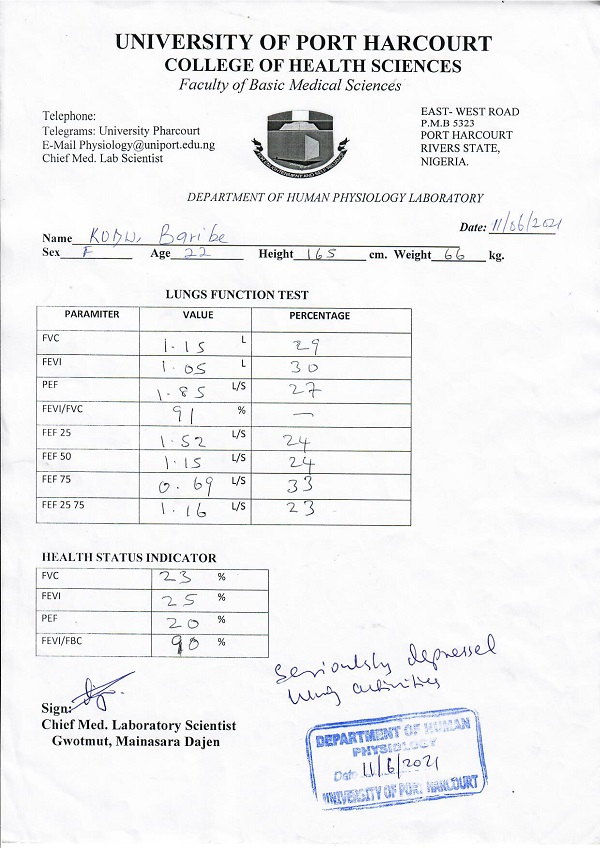
Gwotmut Dajen, chief medical laboratory scientist at UNIPORT’s physiology department, said “the results fell short of standards expected of both male and female”.
“The fact that on the overall, we don’t have an up to standard subject among the five of them is an indication that there’s a general depression of lungs function activities in these subjects,” he said.
Dajen said the implication of the result is that the oxygen intake of the individuals is limited, which portends danger to their health.
“Environment, of which soot is one, is a major factor responsible for this,” he added.
Kodu Baribe, a student of RSU who was one of the persons tested, wasn’t shocked to discover that she has “seriously depressed lungs activities”. Baribe says she knows that the inhalation of soot must have taken a toll on her and others in Elele, Obio/Akpo where she resides.
“I am really not shocked. We know that the soot is a problem but nothing has been done about it. Sometimes, I notice the difficulty in breathing and chest pain from the accumulated dirt that comes from the air,” she said.
TheCable’s findings corroborate a 2021 study, which examined the ambient air of Port Harcourt, and revealed there is “a high probability of accumulation and toxicity in human tissues and health” due to the poor air quality in the city.
CHEST X-RAY SHOWED NO IMMEDIATE ADVERSE EFFECTS
The chest x-ray results of the participants showed that majority of them are relatively okay, as there were no issues with the sampled parameters among the individuals.
Best Ordinoha, a professor of community medicine and environmental health at UNIPORT, explained that even though the chest x-ray results showed that the participants were normal, it does not mean they are not affected by soot.
He said the effect of the soot is based on the “defensive mechanisms” of each person.
Ordinoha, who is also a health consultant at the University of Port Harcourt Teaching Hospital (UPTH), added that the effect of soot can be immediate or delayed.
“The immediate effects will include hypersensitivity reactions like asthmatic attacks and sneezing,” he said.

Ordinoha said some of the delayed effects in adults include increased risk of lung cancer and bronchitis while children are at the risk of having pneumonia.
“In most cases, it takes a longer time for some of these adverse effects to manifest. So, basically, people will still feel the adverse effect but their body and lungs may appear okay because the vast quantity has been filtered out by those defensive mechanisms,” he said.
Orji Sunday, a former resident of Port Harcourt, told TheCable that soot pollution informed his decision to relocate from the city in November 2020.
“I left Port Harcourt because of the soot issue. It was prevalent around First Artillery axis of the state where I was living at the time,” he said.
But unlike Sunday, many who have nowhere to go have resigned to fate, huffing and puffing while hanging on to the hope of a clean environment devoid of soot.
GAS FLARING, BUNKERING BOOMING — BUT WHERE ARE THE REGULATORS?
When Lukeson Oguchi returned to Mgbede community in Ogba/Egbema/Ndoni LGA after his master’s degree abroad, he was saddened by widespread pollution in the area.
Although the 2019 study by the state government revealed that “eradication of the soot depends on the reduction or complete extermination of the identified factors causing soot”, TheCable found that not much has been done to stop the causal factors.
In several parts of Rivers, illegal bunkering and artisanal refining are lucrative businesses while those involved are mostly unchallenged by relevant authorities.
According to Oguchi, the ease at which people carry out the illegal activities and the attendant profit remain a motivating factor for many residents.
“They (illegal oil bunkers and artisanal refiners) make a lot of money daily and in my place, it’s gradually becoming a business that every young boy and young girl wants to get involved,” he said.
“Here, if you invest N13,000 you will make up to 15,000 and 20,000 daily. Those who invest N2 million get up to N500,000 daily.”
The negligence of security and regulatory agencies in addressing the situation was obvious during visits to Aggah and Okwuzi in Egbema; Rumuokparali waterside in Obio/Akpo; and Obigbo west in Oyigbo LGA.
TheCable also found that products — such as kerosene, petroleum and diesel — from these illegal activities are openly displayed for sale in markets and within residential areas.
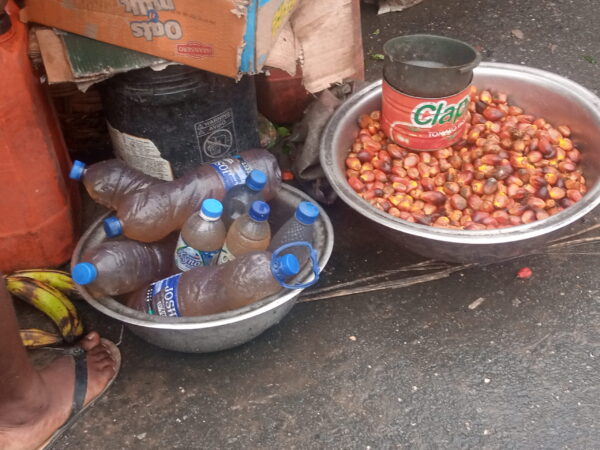
Just like illegal bunkering, oil companies still openly flare gas at the detriment of their host communities.
Ebocha community in Ogba/Egbema/Ndoni LGA, for instance, hosts the Ebocha Oil Centre owned by the Nigerian Agip Oil Company Limited (NAOC).
Residents said the company’s operations have become a nightmare for them due to constant flaring of gas and oil spillages.
According to Stanley Anyaladu, chairman of Egbema community development committee, the area has continued to suffer “massive pollution” since Agip discovered oil in commercial quantity.
“There has been massive pollution of our area since 1965 when Agip discovered oil in commercial quantity in Ebocha. Black soot is common because the volume of oil activities and degradation of the ecosystem is very massive here,” he said.
“Lungs diseases and other respiratory issues are prevalent here. We also notice that some of us are already growing grey hair as early 18 and 19 years of age.”
Eze Augustus, Ebocha’s council of chiefs chairman, said the activities of Agip have contaminated the water and the environment.
“Agip has left us poorer than they met us because of their rule and divide policy. Our water has been polluted while we inhale soot and other harmful substances on daily basis due to gas flaring,” he said.
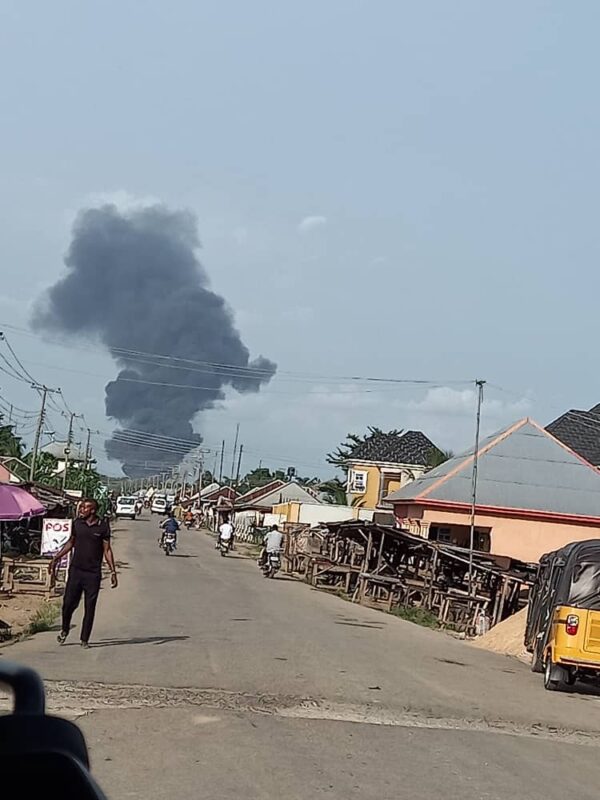
In Finima, Bonny LGA of the state, there is also constant flaring of gas by the Nigeria LNG Limited (NLNG) and other companies.
Warialabo Amoni Hart, chairman of Finima Environmental Protection Initiative (FEPI), said the government has turned a “blind eye” to the situation in the area which he claims has continued to kill people.
“In Finima, there’s high casualties of respiratory diseases, high blood pressure and health complications because of the soot from heavy gas flare. There’s also serious concentration of lead poisoning in the marine life,” he told TheCable.
“Oil and gas companies such as NLNG, ExxonMobil and Shell international flare gas here. The government is aware that the citizens are being killed with pollution and that they should do something, but they’re just turning a blind eye.”
Nigeria is a signatory to the African Charter on Human and Peoples’ Rights which states that “all peoples shall have the right to a general satisfactory environment favourable to their development”.
The country has also ratified the Paris climate agreement — aimed at reducing global warming — while it is also a signatory to the Global Gas Flaring Partnership (GGFR) principles for global flare-out by 2030.
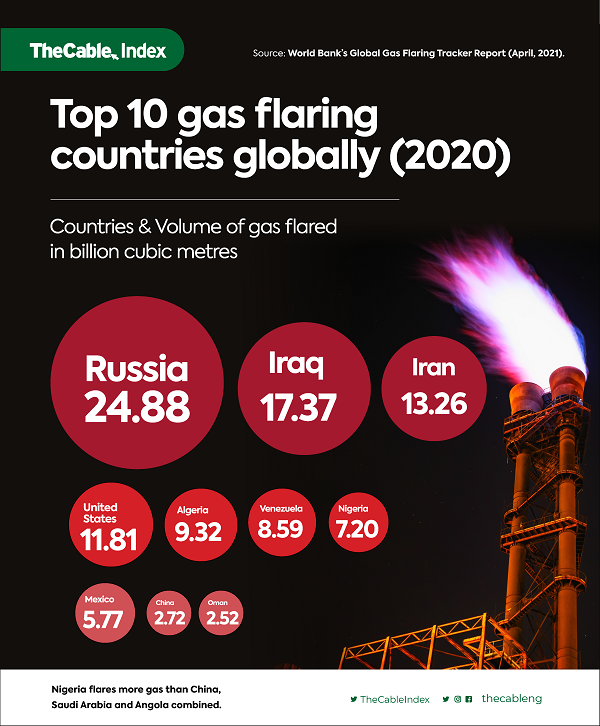
In 2016, the federal government launched the Nigerian Gas Flare Commercialisation Programme (NGFCP) “to eliminate gas flaring through technically and commercially sustainable gas utilization projects”.
At the state level, there’s the ministry of environment “responsible for the promotion of a healthy and clean environment”. There is also the federal ministry of environment established to tackle issues relating to activities causing the soot.
Similarly, there are several other federal agencies such as the National Oil Spill Detection and Response Agency (NOSDRA), Department of Petroleum Resources (DPR) as well as the National Environmental Standards and Regulations Enforcement Agency (NESRA) saddled with this responsibility.
But in spite of the existence of all these instruments and regulatory bodies, gas flaring, illegal bunkering, artisanal refining and other activities causing soot pollution are still rife in Rivers.
According to the World Bank gas flaring tracker report released in April, Nigeria is among the top seven gas flaring countries in the world for the last nine years.
‘IT’S A DIVIDE AND KILL BUSINESS’
Residents who spoke with TheCable attributed the unchecked rate of activities promoting soot in Rivers to the collusion between security and government agencies with those involved in the “business” — a claim that was also established in the 2019 report.
Oguchi said in spite of the environmental hazards caused by oil companies in the area, they are heavily guarded by security operatives that often clampdown on youths who try to protest.
“The government, regulatory and security agencies are all in this together with the multinational companies; they’re the direct beneficiaries of whatever is going on. It’s a kill and divide business that they’re doing,” he said.
Sylvester, another resident in Egbema, said: “The beneficiaries are making fortune out of the situation and leaving the poor to die more. The soot is killing us slowly.”
Eugene Abels, leader of the #StopTheSoot campaign in the state, said the scourge has demonstrated the failure of the state and federal governments.
“All tiers of government and regulators have shown negligence of duty and responsibility to the oaths which they swore to upheld and protect the lives, fauna and flora of the nation,” he said.
Reacting to TheCable’s findings, Sharon Ikeazor, minister of state for environment, said the ministry “is not relenting on efforts to curb oil spillage, gas flaring and dangerous work of artisanal refiners”.
She, however, did not respond to enquiries on measures put in place to punish oil companies and individuals responsible for activities causing soot in Rivers.
When contacted, Idris Musa, director-general of NOSDRA, confirmed TheCable’s findings that oil companies still flare indiscriminately and that illegal oil bunkers and artisanal refiners are operating unchecked in Rivers.
“All those places you mentioned, I know very them well and I can tell you in terms of oil spill, gas flare and artisanal refining, they’re common there and the waterways there are polluted,” he said.
“Ebocha Oil Centre is one of the areas where gas is still being flared because there is a flow station there. We also have the Brass terminal and others there. In Finima where you have the NLNG, there is Bonny oil and gas export terminal and others.”
Musa said the agency is regulating the oil companies against flaring of gas through various measures, adding that “those who cross the red line in the past have been sanctioned”.
The NOSDRA DG said the agency is working with the Nigerian Navy to tackle illegal oil bunkering and artisanal refining, adding that efforts are ongoing to fish out those who aid the criminal activities.
On his part, Paul Osu, DPR’s head of public affairs, said the agency has several initiatives in place to tackle gas flaring but he did not address TheCable’s questions on penalties meted to oil companies found wanting.
TheCable could not get the reaction of the state ministry of environment on the matter. But when contacted, Princewill Chike, the commissioner for health, declined comment.
Nnamdi Omoni, the state police command’s spokesman, also declined comment on alleged collaboration between security operatives and illegal oil bunkers and artisanal refiners.
This is a special investigative project by Cable Newspaper Journalism Foundation (CNJF) in partnership with TheCable, supported by the MacArthur Foundation. Published materials are not views of the MacArthur Foundation.
